By Anton Huggler
Editor’s note: A story by R.J. Rubadeau in our September 2024 edition, “On Becoming a Captain” (windcheckmagazine.com/article/on-becoming-a-captain/), recounting a transpacific yacht delivery from Sydney to San Diego, brought back memories for Anton Huggler, who served as first mate for a transatlantic delivery on the same yacht, one of the legendary Ondines.
1976, end of September, Saint Tropez, France
Ondine was readied for an Atlantic crossing back to the U.S. after racing and cruising the summer in the Mediterranean. Her owner Huey Long* had just left when I arrived in port and joined the delivery crew. It was a bunch of youngsters under the command of Mark, a New Zealander of almost extreme dimensions. His chest and shoulders were massive, his legs modeled after columns of Greek temples, his feet in Top-Siders marked 15, maybe 16, if such a size even exists, his hands like tennis rackets…He was BIG! We never questioned his authority. It took a slight hit, though. But about that later.
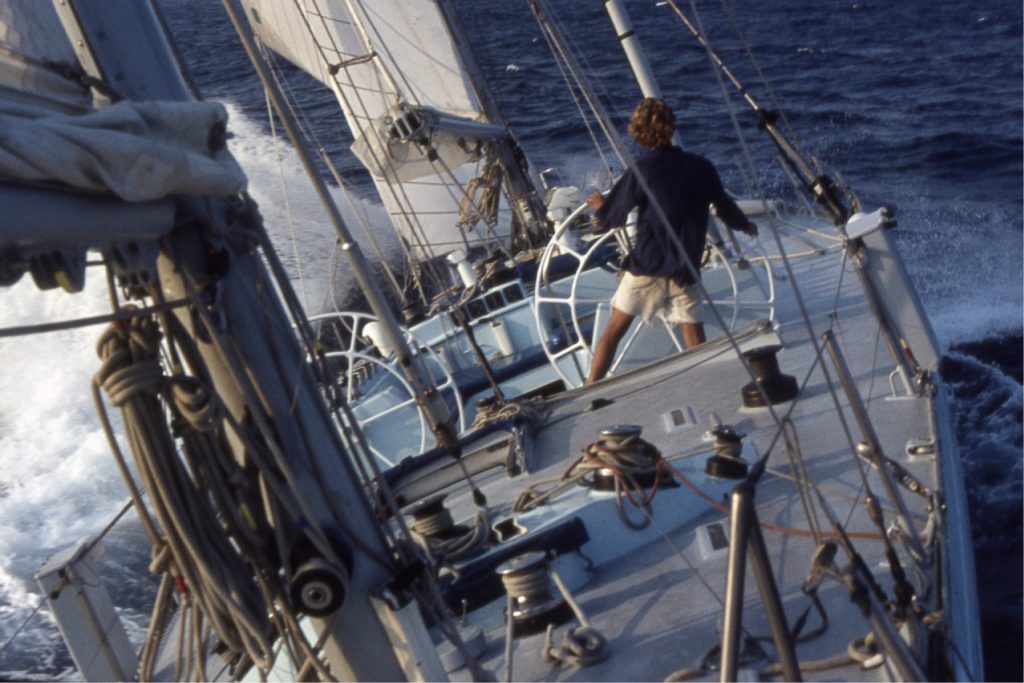
With two masts of equal height (essentially a schooner), a “centerboard-keel” in a trunk, and a canoe-like aft underbody, Ondine’s design was unconventional to say the least.
We sailed the first leg in pleasant fall conditions, sunshine and a nice westerly breeze, to Puerto Bañus in southern Spain. After the overnight stop, we sailed on to Gibraltar. We spent a few days giving the boat a good wash, drying and packing away sails we would not need during the crossing, and adding two large oil barrels to serve as extra fuel tanks, lashed on deck on both sides of the cockpit. It was an ugly addition, and I wasn’t in favor of even having them. If for whatever reason there had been a leak, it would’ve made for a very messy deck and mostly a dangerously slippery one, not to mention the stink and pollution.
We also had some sewing classes and tried as best we could to re-stitch some seams on a couple of sails. Those were of the pre-fancy-cloth era. To suit the ship’s size, the cloth was thick and the hand-driven sewing machine was a tad under-dimensioned for the job. We wished we could’ve had it attached to a coffee grinder.
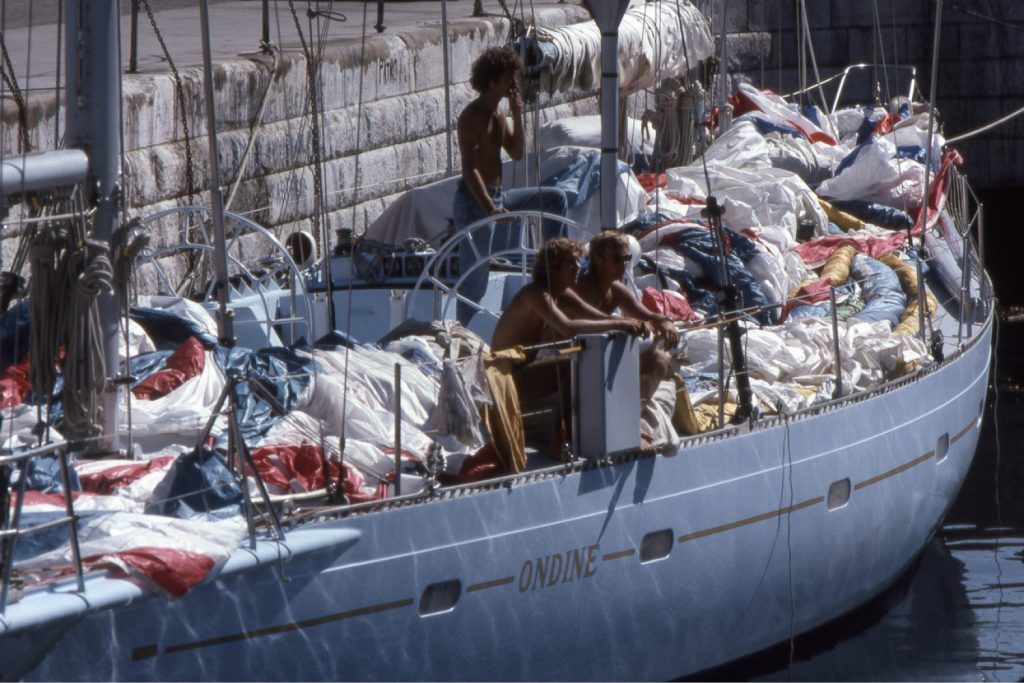
“Sitting around on our fannies” in Gibraltar
The short arm of the machine wasn’t exactly making it easy to wrestle the large sails strategically in a way to offer the spot in need of repair to the needle. It all took the combined and orchestrated effort of three of us able-bodied seamen, and still the result was not pretty.
Gibraltar, very British at the time, was also still blocked off from shore access by the Spanish. With entertainment rather scarce, we were a welcome attraction on the waterfront, to be ogled at and of course there were questions. Two decidedly British and elegant elderly ladies were inquiring what we were doing during our free time. Bobby, a curly haired, mustachioed American sporting bright blue reflecting sunglasses, replied, “Well, we mostly just sit around on our fannies.”
That anatomical reference may be an acceptable expression in Yankee English, however for the distinguished variation spoken by the subjects of the Queen of England, it’s a word that raises eyebrows and it had the two ladies blushing. Being Swiss and new to American slang, I learned Bobby meant he was just sitting around, while in Britain the term is more properly used amongst longshoremen. But then again, we definitely belonged to their class more than the educationally elevated sightseers walking the pier.
We were surprised by an additional crew coming on board. Huey’s lady friend, Davina, was from London and very beautiful. Apparently, she liked sailing and had begged Huey to come along. In some tabloids, we’d read that she was a fashion model and she was going to cook for twelve seafaring men, preparing meals in a tiny galley and at an angle of 45 degrees, while sailing the treacherous Atlantic. Hmmm…perhaps a bit embellished. In fact, there were only six of us and we already had a cook, a young girl from Bermuda.
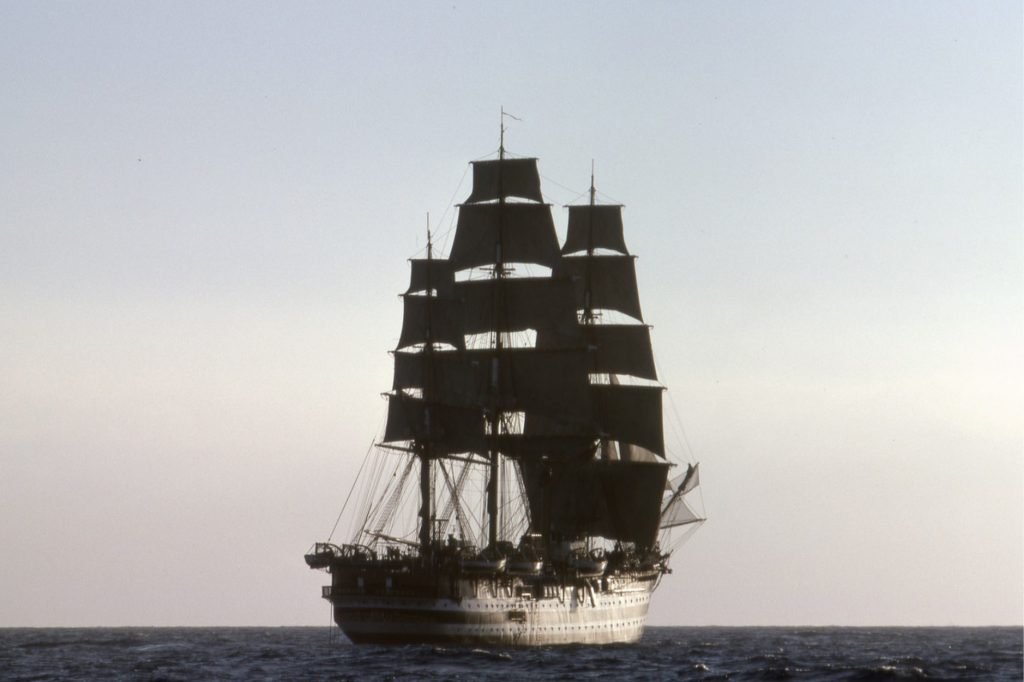
Crossing tacks with the Amerigo Vespucci
Sailing for Madeira, one morning there was a rare sighting. The Italian Navy’s sailing vessel Amerigo Vespucci appeared on the horizon under cloud of sail. We were on opposite course and passed each other very closely. While not as sleek and elegant as the U.S. Coast Guard’s Eagle, she was impressive and beautiful.
On that same leg, we sighted a bewildering scene playing out on the sky. A very bright light appeared and after a fast approach, slowed down to a standstill, hovering and slowly following us for some ten minutes. Then, with a sudden burst of speed, it disappeared. It was a clear, star-filled night and we all saw it, agreeing it was not a known aircraft as there was no noise. It was also difficult to tell at what altitude this bright and shiny object was flying. I am not easily convinced of extraterrestrial vehicles, but with none of us having a plausible explanation…Madeira was another one-night stop, offering a brief stroll ashore and a cold beer, and off we were. Bermuda next.
The crossing was uneventful, with favorable wind and weather allowing us to sail all the way. On occasion, we set the kites. Ondine was at her best and on her most enjoyable course, a broad reach. The keel, shaped like a centerboard of a dinghy and housed midships in a trunk, was lowered and raised, secured by very thick ropes and operated by hydraulic pumps. The whole construct had me a bit uneasy. As much as it improved speed on a downwind course, I questioned its integrity and how the board would be held safely in its trunk when slamming to windward in a heavy sea. That experience would come short of New York.
Of some concern was our cook’s repertoire. She hailed from Bermuda, a British protectorate, and I guess they also protected her cuisine. It was very limited. We had a large freezer compartment and she had bunkered chicken and fish. A lot of it. All the same. Every morning, a pack of frozen goods were placed in the cockpit to thaw. The distinctive aroma let us guess what the day’s fare would be; a rotating surprise of fish or chicken. Adding to this monotony was the fact that she’d unfortunately not been trained by a French chef. Her artistry in the galley was as limited as the menu. Sauteed it was, both the ocean creature and the rubber bird. We suffered. Except for Mark. He thought it was delicious. But then, besides the cook herself, he was the only member of the British empire. The crew was of the mercenary type, hailing from various nations. Bobby, Dan and Michael from America, Hans from Holland and myself Switzerland, and we all had more discerning palates.
Hans was fresh out of the Dutch Navy and seeking adventure. We were on watch together. His navy routine still ruled his day. Regular trips to the foredeck and back had him inspecting the nav lights. We had them switched off when sailing in clear conditions, to save power. This did not meet his standard and upset him greatly. “Ve haf to haf de lites!! It iz de roohl!!” Invariably, he went down below to switch them on. Equally invariably, I switched them off again. All remained calm. Until he went on his next inspection stroll to the bow.
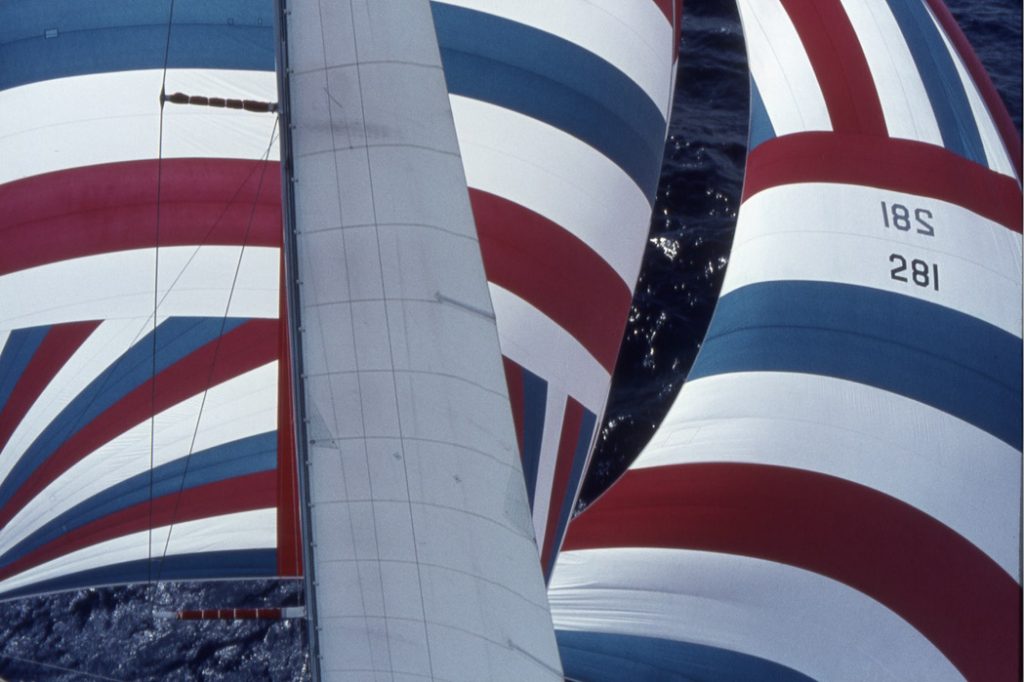
Bloopers were in full bloom in 1976
Then there was a little development. Davina liked Mark. It became quite obvious when she was taking pictures and called out to him, “Mark, Mark! Flex your muscles!” which he willingly did. Now, Ondine had a center cockpit, forward of which were the main cabin, galley and nav station. Aft of the cockpit was the owner’s cabin. Since Huey was not on board, we used it for storage of sails and equipment. Well, Davina was not too comfortable bunking with her seafaring men. And Mark, very concerned about her wellbeing, ordered the aft cabin to be emptied, and prepared for her to take up residency. Just her…?
This then led to some nasty surprise for Huey when we arrived in Saint George’s on Bermuda. It was nightfall and Mister Long was at the dock, happily whisking his girlfriend off the boat. The next morning, we motored Ondine around the island to Hamilton and tied up in front of the Princess Hotel. We all were looking forward to a couple days of rest and recreation, and mostly a good pub and a steak.
Not so. I was hosing down the deck when Huey came down the dock. “What are you doing here?” he asked. “Well, Mister Long, we need to give the boat a good wash, then also restock on food,” I replied. “Get food at the hotel. I want you to leave at 1400 hours !!” And leave we did. Including Davina…
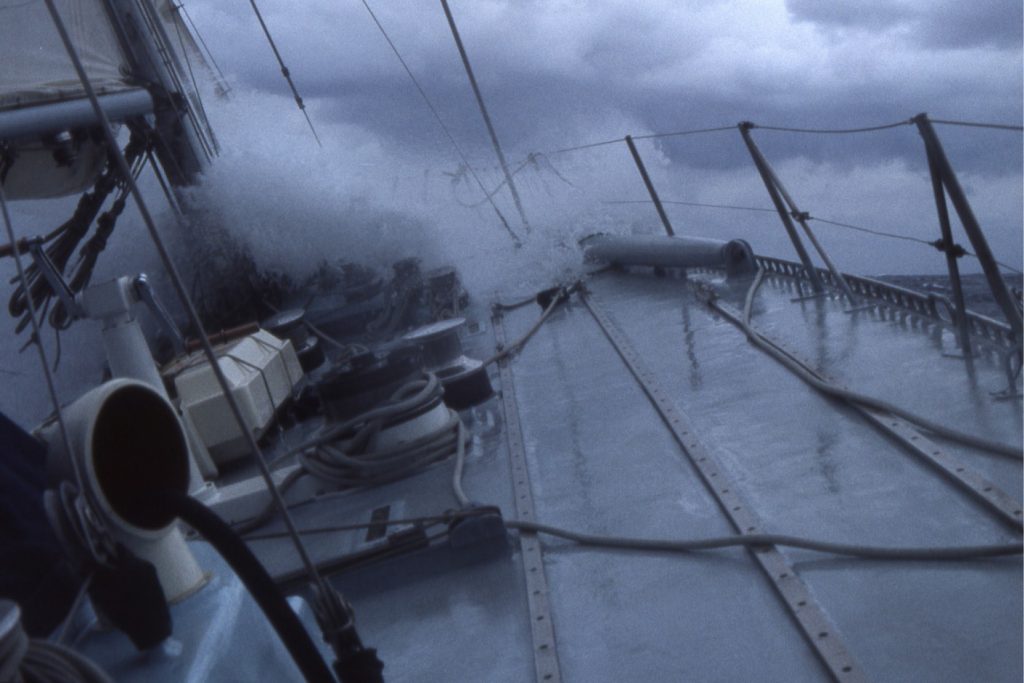
Rough weather before landfall in New York
On the last leg, to New York, we got hit by some nasty weather. Not only did the temperature drop drastically once we left the Gulf Stream, a strong westerly front had us gradually reducing sail, until we were bashing to windward under storm jib only. It was rough and I had an afterthought about the integrity and stiffness of the hull, when at the bow, looking back, I saw the two masts swinging perpendicular to the boat’s axis but not in sync. There was considerable torsion of the hull. I didn’t like it.
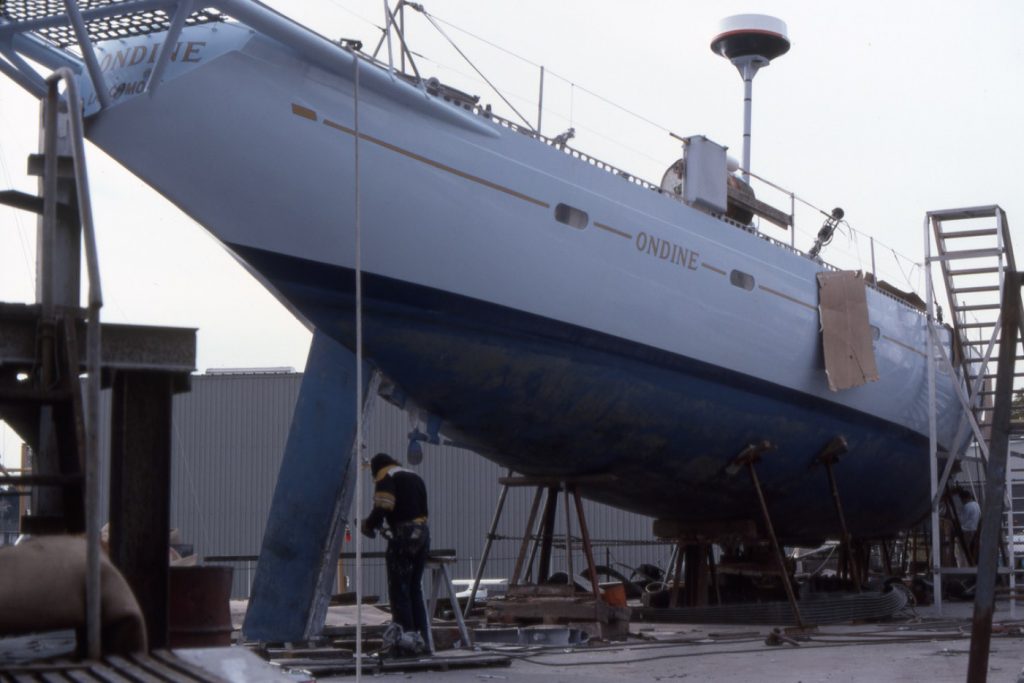
On the hard in Mamaroneck, with auxiliary “fuel tanks” visible on deck
The yacht’s designer, Britton Chance, Jr., was known for some unconventional thinking. Although the mizzen mast (which was the same size as the main mast) was stepped just a few feet forward of the transom, I could not accept this being a well thought out and structurally safe design. This experience in heavy weather, the “centerboard-keel” in its box, the two identical masts and the torsion, the canoe-shaped transom section of the underwater hull, and the center cockpit layout were not to my liking. I’d had high expectations and was much looking forward to sailing on Ondine when I joined her in Saint Tropez, but after arriving in Mamaroneck I was disappointed.
This influenced me to end my boat bum years, and I decided a professional sailor career was not for me. Instead, I went back into architecture. I’d considered naval architecture, and worked in the design offices at Huisman in Holland and Nautor in Finland. At Huisman I’d met an American who offered me a job in his engineering firm in Athens, Greece, and sail races on his yacht.
But that’s another story… ■
Born and raised in the Bernese region of the Swiss Alps, Anton Huggler began sailing on Lake Thun at age 12. He raced dinghies, Dragons and Solings while studying architecture. Emigrating to South Africa in 1971, he sailed several Admiral’s Cup and Sardinia Cup races and the Cape Town to Rio de Janeiro Race in ’73 and ’76, crossing the Atlantic four times that year. He singlehanded the Carter 37 Sarabande from Antigua to Gibraltar, calling it his best trip ever. Now residing in Stonington, CT, Anton reflects, “Much to my regret, I sold my Swan 371 and am actively looking into courting financial disaster by gifting myself a Swan 391. This is America. Bigger is better, right?”
*A winner of many of the world’s most challenging ocean races, Sumner “Huey” Long (1921-2011) was a graduate of the U.S. Merchant Marine Academy at Kings Point and MIT, and a successful shipping executive. He commissioned a series of racing yachts named for a mythical sea nymph, Ondine (homeport Larchmont, NY) and influenced many other famous yachtsmen.




